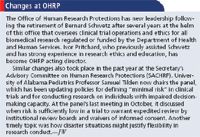Changes and Challenges in the Year Ahead
Applied Clinical Trials
FDA and sponsors implement FDAAA as pressure builds to curb drug prices and tweak the R&D process.
The new year begins on a note of optimism. A major breakthrough in stem cell research promises to open the door to new biomedical research opportunities. The drawn out Congressional debate over user-fee reauthorization and drug safety regulation is over, and most parties seem satisfied with the resulting compromises. The vaccine industry is experiencing a resurgence after years in the doldrums, with important new vaccines on the market and more under development. Unlike many previous years, the Food and Drug Administration had a confirmed commissioner for all of 2007 and relatively stable leadership as a result.

Jill Wechsler
Sponsors of new drugs and medical products will be busy in coming months as they face continued scrutiny of drug safety and other challenges:
Implementing FDAAA. The legislative wrangling is over, and now the lawyers are in charge of deciphering what members of Congress really intended for many complex and contentious portions of the FDA Amendments Act. The main thrust of FDAAA is to promote drug safety by imposing added requirements on sponsors and enhancing FDA's authority. FDA now can require labeling changes, expanded clinical trial registration and results disclosure, additional postmarket studies, and curbs on DTC advertising. Sponsors hope that these more stringent policies, plus the threat of fines on companies that fail to follow the rules, will restore public confidence in FDA's regulatory capabilities.

Changes at OHRP
As the implementation process begins, FDA officials and legal experts acknowledge considerable uncertainty about many FDAAA provisions. One question is how and when sponsors will have to file Risk Evaluation & Mitigation Strategies (REMS), especially for high-risk drugs already on the market. FDA has to clarify a process for tracking and enforcing compliance with Phase IV study commitments. And new requirements for registering a greatly expanded range of clinical trials and trial results present a substantial challenge for FDA and the National Library of Medicine.
FDA deputy commissioner Janet Woodcock indicated that a REMS may not be required for all drugs, in discussing FDAAA at a Food and Drug Law Institute (FDLI) conference in November. The agency will use its REMS authority "judiciously," she commented, noting that too many restricted drug distribution programs could increase confusion, harm patients, and decrease access to the therapy.
Safety slowdown? While implementing new programs, FDA faces the challenge of demonstrating that it has not become overly gun shy about approving new drugs for market. New drug approvals were down last year, as well as the number of new molecular entities (NMEs) coming to market. FDA is issuing many "approvable" letters that frequently request additional clinical trials to further assess safety issues, and many approvals carry narrower indications. Black box warnings seem to be proliferating, as well as agency safety alerts and advisory committee reviews of safety issues for certain drugs and drug classes.
FDAAA moves to address these concerns by revising the presubmission meeting process to support a more predictable drug development and review process. The aim is to discuss drug safety and reach agreement on postapproval studies and product labeling earlier in order to avoid delays and achieve more first-cycle reviews.
Attack on drug pricing. The Medicare Part D drug benefit has significantly increased government payments for drugs, intensifying public scrutiny of prices, especially for costly biotech treatments. High Medicare expenditures for anemia-fighting erythropoietin (EPO), for example, sparked Congressional investigations and led to a curb on Medicare reimbursement for the drug.
Efforts to reduce the nation's prescription drug bill continue to fuel the campaign to grant the government authority to negotiate drug prices for Medicare Part D plans, to further limit drug advertising, to require more disclosure of manufacturer prices, and to speed access to more low-cost generic drugs. To achieve this last goal, Congress will continue to seek a pathway for FDA to approve follow-on biologics. The legislators decided to drop such a proposal from FDAAA, but generic makers have not let up efforts to resolve the issue, and projections of big cost savings from biosimilars are likely to keep the topic on the front burner in the coming year.
Push for comparative effectiveness analysis. The process for determining appropriate drug prescribing and pricing stands to benefit from comparative effectiveness reviews of medical procedures and products. Better information on what medical treatments work best for certain patients could reduce excess drug utilization, avoid unnecessary or harmful procedures, and support a more efficient and less costly health care system. These possibilities are boosting support for a larger government role in assessing medical treatment effectiveness, while health plans and payers also are demanding more evidence that medical products are cost-effective as well as safe and efficacious.
The challenge for pharma companies is to encourage analysis of how medicines compare to alternative medical and surgical procedures, and to avoid using comparative assessments to control costs or to deny coverage for innovative products. Even if a study indicates that a drug may be less effective for many patients, there should be room to prescribe that product for a smaller patient population that may benefit.
Spurring innovation. In order to bring new therapies to market more efficiently, FDA continues to work with industry to develop new methods for testing and assessing drug safety and efficacy. The agency's Critical Path Initiative (CPI) encourages public-private partnerships to develop new biomarkers, assess drug quality issues, and explore new approaches for ensuring product safety. An important project aims to improve methods for assessing liver toxicity in preclinical testing. FDA recently launched a collaboration with Duke University Medical Center to streamline clinical trial operations through electronic data standards, updating review board policies, and establishing accreditation programs for clinical investigators and research sites.
Curbing conflicts of interest (COI). Some members of Congress and consumer advocates want to keep scientists with industry ties from serving on FDA advisory boards. FDAAA allows some conflict-of-interest waivers so that experts will be able to provide advice when needed. FDA has issued new policies to make COIs and waiver policies more transparent and is taking steps to meet Congressional requirements for reducing waivers overall.
Concerns that drug manufacturers exercise too much control over FDA policies have emerged related to the role of the new Reagan-Udall Foundation, created by FDAAA to support innovation and enhance safety for FDA-regulated products. FDA met the deadline for naming a panel, headed by former FDA commissioner Mark McClellan, to oversee the new organization. But Rep. Rosa DeLauro (D-CT), who chairs the House Appropriations subcommittee in charge of FDA's budget, has objected that industry influence may lead the foundation to encourage development of more profitable, but not necessarily safer, products.
DeLauro plans to hold hearings on Reagan-Udall and other COI issues while also directing how the agency spends its annual budget. Sponsors have joined with the biomedical research community and other parties to urge a significant boost in resources for FDA to deal with continually expanding responsibilities. A big increase in user fees may alleviate some of the shortfall for regulating new drugs, but delays in Congress approving 2008 appropriations bill for most federal agencies blocked FDA from being able to tap into these resources for several months. The budget squabble, moreover, casts doubt on prospects for any significant increase in FDA funding in the future.
Jill Wechsler is the Washington editor of Applied Clinical Trials, (301) 656-4634 jwechsler@advanstar.com

FDA Fast Tracks Johnson & Johnson’s Nipocalimab for Fetal Neonatal Alloimmune Thrombocytopenia
March 27th 2024Johnson & Johnson is moving forward with a pair of Phase III trials of nipocalimab to reduce the risk of fetal neonatal alloimmune thrombocytopenia in alloimmunized pregnant patients.
Citius Pharmaceuticals Resubmits BLA to FDA for Lymphir to Treat Cutaneous T-Cell Lymphoma
March 19th 2024Pivotal Phase III Study 302 trial data show an objective response rate of 36.2% based on an independent review committee assessment in the treatment of relapsed/refractory cutaneous T-cell lymphoma.